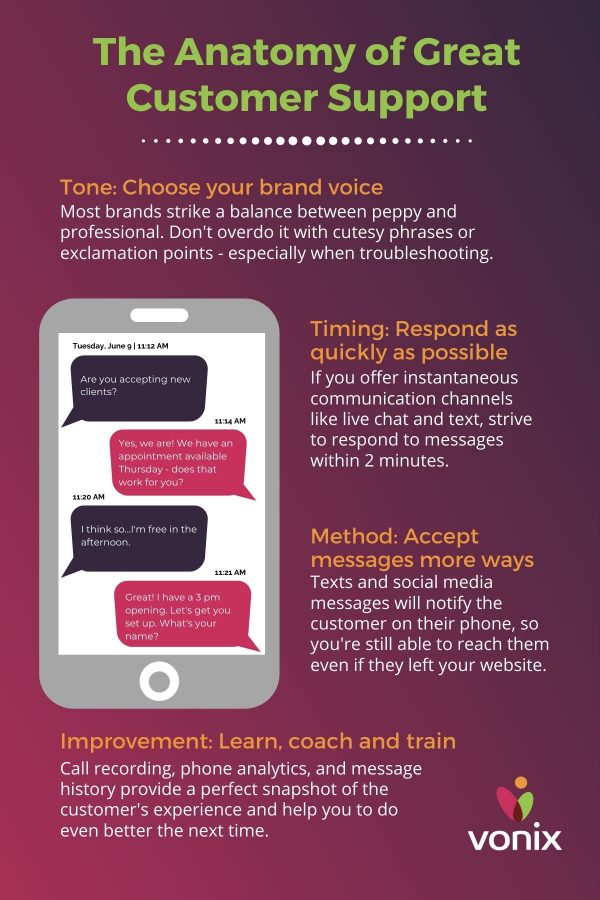The way your company handles a support request has lasting impacts. Whether a customer has a routine question or is experiencing a more complicated issue, how you respond informs their impression of you. This affects the rest of their lifecycle, including if they want to continue doing business from you and how likely they are to recommend you to others.
Great customer support is intentional, not an accident. Here are four customer service areas to focus on to build a support strategy that keeps customers coming back.
 1. Tone: How You Say It
1. Tone: How You Say It
Too many companies train their teams on their products and solutions but don’t talk about tone. Your brand voice refers to the personality and emotion imbued by your company communications. Brand voice is often discussed in terms of website content and social media posting, but it should extend to live chat, email communications, and phone service you provide.
For instance, a law firm may want to sound more professional while a bakery may be more chipper. Review how your agents greet people, provide answers, and sign off to make sure that they’re staying true to your brand.
2. Timing: How Quickly You Respond
Your customers are busier than ever. In fact, 20% of them won’t continue doing business with you if you take too long to respond to their requests! First, you need to ensure that every message is being answered. Then, focus on speed. You need to cut down on the time it takes for the customer to be acknowledged and responded to. This will keep them from dropping out of the call, text, or message chain and make them more likely to purchase or return.
Invest in tools offering group inboxes, so that whoever is available can help the next customer. Additionally, agents will be able respond to multiple messages at a time as they come in. You can also update your phone system’s features to provide common answers quickly in a custom menu. You’ll receive fewer repetitive calls and free up your team to handle the bigger issues.
3. Method: How Customers Can Reach You
Are you still relying on a contact form on your website to field questions? If so, you need to diversify how many channels customers and prospects can reach you on. Customers prefer to use phone, email, and live chat in almost equal amounts. So, if you have a customer that doesn’t like email, they probably prefer the phone for quick questions. You don’t want to lose a potential buyer because you don’t offer the method they prefer.
Additionally, newer communication methods are actually better for your business. Updated VoIP phone systems help keep your customers on the line and to the department they need. Meanwhile, text and social media messaging will reach the customer even if they’ve already left your website, unlike live chat. Your customers will appreciate being able to use the method most convenient to them and will be more likely to remain loyal to your brand.
4. Improvements: How Can You Do Better?
Every customer service agent is too familiar with asking their customers to stay on the line for a brief survey. Often, the people who choose to answer these are extremely happy or disappointed; you lose a lot of the in-between data. Plus, the data could be skewed. Perhaps there was an issue that just couldn’t be solved, no matter how good of a job your agent did at handling it. Or, if a customer thinks that compensation and bonuses are tied to great service, they may feel pressured to just give all 5’s, regardless of how it was handled.
Self-reported data is always flawed. That’s why automatically recorded data will give you another layer of insight into the operations of your business. For instance, call times, speaking times, and call quantities can provide a lot of information into how your team is spending their time. With this data, you can determine goals that are based on real conversations instead of random industry metrics. If you need more detail about how something was handled, you can always review recorded calls and view text and message history with a client to see the full story. With all this information, you can better coach your team, provide helpful feedback, and catch great examples of service to strive towards.
Better customer service pays off in dividends for your company in terms of lifetime spend, increased loyalty, and referral potential. The core of a great customer service team is the tools they use to facilitate conversations. When your team can use one centralized program to manage all customer communications, they can spend more time focusing on helping your customers. Learn about Flex by Vonix, our all-in-one chat, messaging, and calling solution.

 1. Tone: How You Say It
1. Tone: How You Say It








